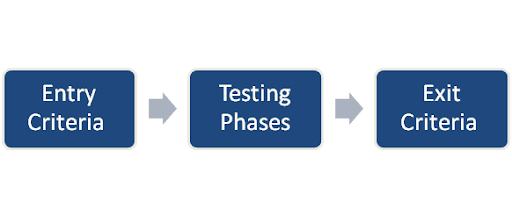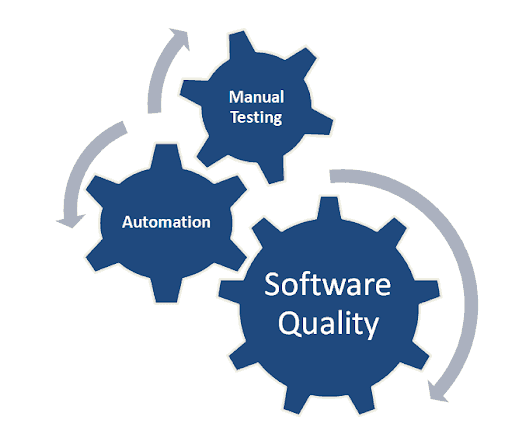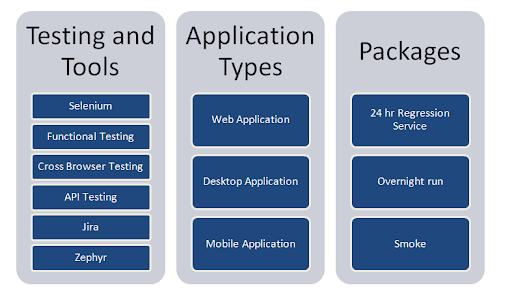Accelerate Success with AI-Powered Test Automation – Smarter, Faster, Flawless
Start free trialManual Testing is the process of confirming that the manufactured product is the quality product and to assure that the manufactured product is working according to the specifications or not.
The deviation from expected behavior and the desired result is considered as Defects.
What is The Role of Manual Testing?
Manual testing is the process of executing and running test cases or exploring the application to find any deviation from existing behavior without the help of any tool.
Manual Testing is the most ancient and important type of testing and helps find bugs in the software system. Any new application must be manually tested before it can be automated with the help of any tool. Manual Testing requires more effort but is necessary to check automation feasibility.

Each of the above stages has a definite Entry and Exit criteria and Activities & Deliverables associated with it.
Automate testing for your web application in THREE days. Start Free Trial NowWhat is Entry and Exit Criteria?
Entry Criteria: Entry Criteria gives the prerequisite items that must be completed before testing can begin.
Exit Criteria: Exit Criteria defines the items that must be completed before testing can be concluded.

Requirement Analysis:- It is the first phase of STLC and it starts as soon as the SRS is shared with the testing team and In this phase, we analyze functional or non-functional requirement of Application under Test. Requirement Traceability Matrix is the output of this phase. Below are some activities that are performed under this phase:
- Extracting Requirement from Customer
- Analysis and determining any unclear and ambiguous requirement
- Requirement documentation in form of Use cases
- Defining the scope of testing
- Preparing Requirement Traceability Matrix
Test Case Design: – Once we have the Traceability matrix, the next step will be to transform these business or functional requirements into use cases. This phase involves the creation, verification, and modification of test cases & test scripts. Test Cases is the output of this phase.
Implementation and Execution: – During this phase, the testers test case execution will be carried out on the basis of test plans and the test cases prepared. Bugs will be reported back to the development team for correction and retesting will be performed. Execution Status and the Bug report is the outcome of this phase.
Exit Criteria and Reporting:- This STLC phase concentrates on the exit criteria and reporting. There are different types of reports ( DSR – Daily status report, WSR – Weekly status reports), depending on your project workflow and stakeholders’ choice, you can decide on reporting whether you want to send out a daily report, or weekly report, etc.
Test Closure Activities:- This phase includes the following activities:-
– This phase includes verification of completion of the test. Whether all the test cases are executed or mitigated deliberately. There should not be any High Severity and Priority defects in the open state.
– Document creation for any new finding from the whole cycle or any lesson learned from meetings. It Includes what went well and where are the scope of improvements and what can be improved.

What are The Types of Testing Performed Manually?
Black Box Testing
Black-box testing is a technique of software testing that validates the behavior of an application based on business and functional requirements. It is also known as requirements-based, opaque-box, eye-to-eye testing, or closed-box. In this technique, the tester tries to analyze the functionality of the Application under test without knowing much about the internal architecture of the application. Manual Intervention is required in Black box testing to create and execute boundary value and Edge cases from the user perspective.
GUI Testing
GUI testing is the process of testing the Applications Graphical User Interface. GUI testing involves the look and feels of the Application including checking the screens with the controls like menus, forms, buttons, icons, and all types of bars – toolbar, menu bar, Progress Bar, Scrollbar, dialog boxes, windows, etc. This type of testing required a real human to observe the look and feel of the application and suggest the improvement.
System Testing
System testing means testing the system as a complete unit of all modules. This testing is performed after the integration of all the modules or components to verify if the system works as expected or not. System testing can be automated or performed manually as well.
Acceptance Testing
Acceptance testing, a testing technique performed to determine whether or not the software system has met the requirement specified. The main purpose of this test is to evaluate the system’s behavior with the business and functional requirements and verify if it has met the required criteria for delivery to end users.
There are various forms of acceptance testing:
- User Acceptance Testing
- Alpha Testing
- Beta Testing
Functional Testing
As the name explains, functional testing is a type of black box testing which is performed to confirm that the functionality of an application or system is behaving as expected.
Functional testing is done to verify all the functionality of a product.
Database Testing
Databases are the collection of tables that are interconnected. Databases may be at different servers and may not be of the same type. In this testing we check all the actions performed on the database that can be Insert, Delete, Update and Create.
Database testing basically includes the following:
- Data validity testing.
- Data Integrity testing
- Database Performance
- Testing of Procedure, triggers, and functions.
You May Like to Read
Goals of Manual testing
- The major goal of Software testing is to prevent bug during the development phase rather than finding it later.
- Another major goal of Software testing is to assess the quality of a product
- All test cases must be cover all test scenarios through which maximum errors and bugs can be defined from the application.
- Test cases should be written very effectively as the objective of software testing can be measured by the number of logged defects against the number of written test cases.
Automation can’t Replace Manual Testing, Because
- Exploratory Testing:- In exploratory testing, a tester uses his or her creativity, analytical and logical skills, and skills to explore the application under test. This technique finds a new way to get defects every time. As this is a highly intellective and experimental process that requires perception and real human thinking, it cannot be automated.
- Usability testing can’t be automated:- Automating Usability tests is not feasible. Usability testing requires a human to judge the application’s behavior. We can’t create a code to differentiate between “great” usability versus “bad” usability. By skipping usability testing, you’re presenting a huge amount of risk. This progression in the QA procedure is vital to guarantee confidence in the release.
- Sometimes runtime judgments are required about everything that happens in front of your eyes (while you test) and in few cases behind the scenes too.
- Sometimes clear and constant observation is required with questioning, investigation, and reasoning. It demands runtime actions as per the situation, which wasn’t planned while you test.

For more understanding go through our article on Manual versus Automation Testing:-
Role of Manual Testing in Webomates:-
We use a mixture of manual and automation and crowdsourced testing. Test Planning, Test case design, creation and execution of regression, smoke, and Overnight test suite are some of the services that are part of manual testing. We ensure the highest levels of customer satisfaction and create superior solutions for our clients.

Webomates Manual Process:
- Our QA team work closely with the client to get all the requirement and understand the project’s structure.
- After getting the requirement we convert it to the scenarios and then transform it into test cases. Our team implements the best approach to create test cases.
- The next step will be to get confirmation on test cases from our client, for that our team gets the test cases reviewed by the customers and incorporate the feedback that we get.
- Now we have a full-fledged set of test cases and the next step will be to execute them. We offer a guaranteed 24 hr execution to our customers on different platforms with an extensive amount of Exploratory testing by our Manual Team.
At Webomates, we have applied this technique in multiple different domains and successfully delivered with quality defects. We specialize in taking many different software creators’ builds across domains, on 18 different Browser/OS/Mobile platforms and providing them with defects in 24 hours or less. If you are interested in a demo click here – Schedule a Demo
You can also try our AI Test Automation platform – Webo.AI
Read Next –
Continuous testing tools in DevOps
Test Automation vs Manual Testing
Exploratory testing in software testing
Tags: Manual Testing, Software Testing

1 reply on “Manual Testing Explained”
Great explanation of What is Manual Testing. It gives a complete knowledge of what it is and its types. A good read for individuals who are looking to start on it.